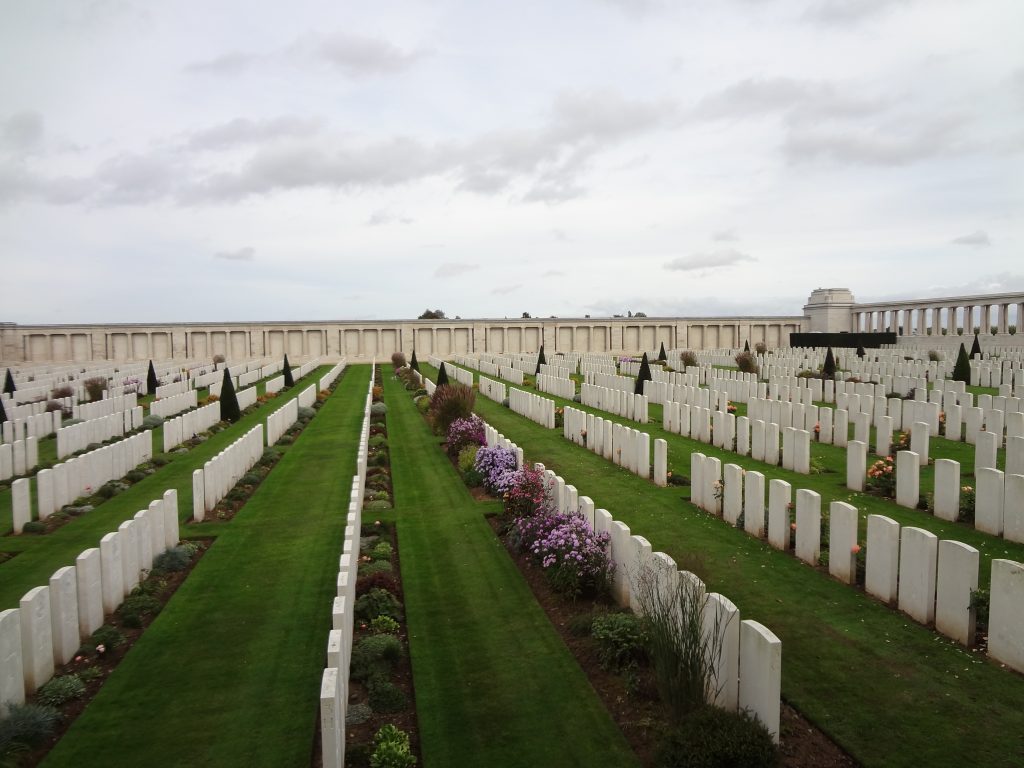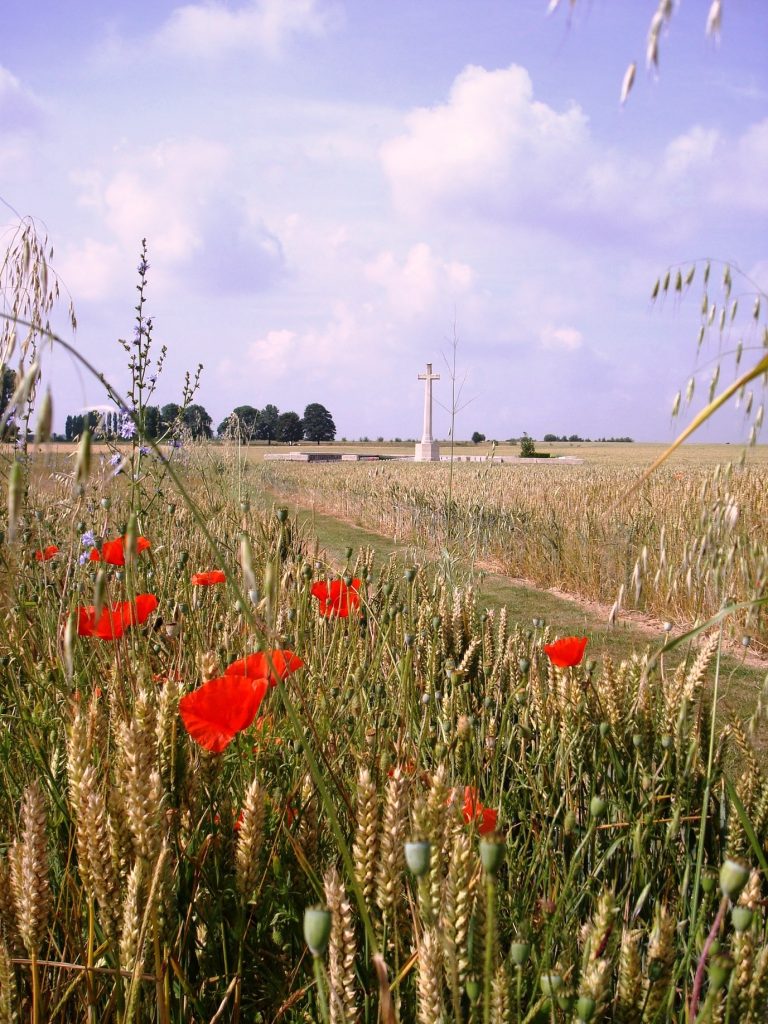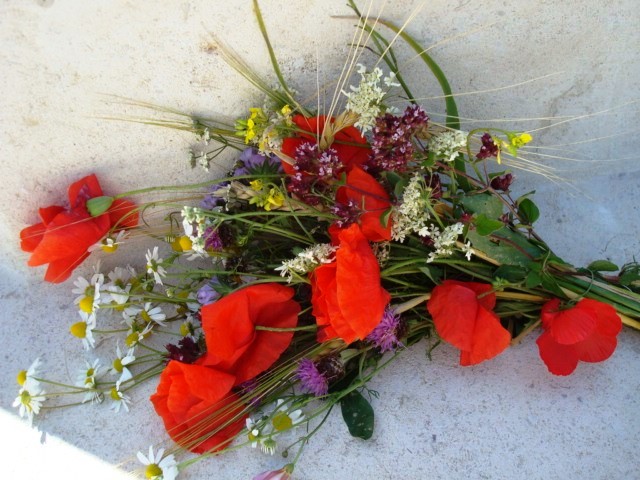102 TOURIST PARTICIPATION IN THE SOCIAL MEMORY OF THE GREAT WAR – Contributions by Caroline Winter
After the Great War of 1914-1918, society promised to remember the dead forever. A fundamentally important decision made by Britain’s Imperial War Graves Commission, was to refuse repatriation of the dead, and to bury them on the battlefields, close to where they had fallen. This created a memorial extending across the old trench lines (Laqueur, 1994), and has formed the basis of social memory and battlefield tourism for a century (Figures 1 and 2). The fields of battle and the cemeteries, together with a number of monumental national memorials, have become central to a well-developed tourism industry that began in the 1920s, and continues to the current day. Most battlefield visitors then, are by definition, tourists, with the majority originating from Europe (especially the Netherlands, France and Belgium), Britain and her former ‘Dominion’ countries such as South Africa, Australia, New Zealand and Canada.
The overarching question guiding my research has always been: How have tourists helped to keep society’s promise to remember the dead? I have located most of my research on the Western Front in the areas of northern France and Belgium that were held by the British forces. I have a personal affiliation with the Pozières, a small village that was central to the Battle of the Somme fought in 1916, and I have applied my studies to this village when it was theoretically appropriate. I have not attempted to interpret the sensitive topic of remembrance for societies for which I am not familiar, including Germany, France and Belgium.
Like many battlefield researchers, I participated in remembrance ceremonies whenever I could, and walked and cycled my way around many military cemeteries and memorials on the Flanders and Somme battlefields, with one visit to Verdun. Initially I adopted quantitative methods, which was a relatively new approach to the field of memory studies, with most work in tourism and history on the subject of the war being qualitative. This research approach allowed me to survey larger numbers of tourists at museums in Fromelles, Passchendaele (Winter, 2018) and on the Somme (Winter, 2012), to measure and compare their motivations for visiting. I also measured tourists’ site connections based on Timothy’s (1997) model of family, local, national and global levels. The study of three memorials in France, Britain and Belgium demonstrated that placement of votives is partly dependent on the personal and national connection of the visitor with the dead (Winter, 2019a).
Visitor books from the military cemeteries formed one of the main data sources for my research, and it allowed me to analyse unsolicited comments from tourists at many large and small, widely dispersed sites. I was fortunate to be given access to visitor books dating back to the 1920s at the American cemetery at the Meuse-Argonne in France (Winter, 2020). In order to understand how early memorialization on the Western Front may have begun, I used literature from studies of Ground Zero in New York after the 2001 terrorist attacks, which suggested there may be some similarities in remembrance practice across the century (Winter, 2016a).


Tourists are integral to social memories of the Great War
The main contribution of my research has been to link tourism with Halbwach’s theory of social memory, and Jay Winter’s (1995) extension of memory to the Great War. Prior work on battlefield visitors tended to be taken from an historical perspective (Jay Winter, 1995), typically with a national focus (Slade, 2003), centred on pilgrimage, rather than tourism (Lloyd, 1998) and based on small, qualitative studies (Dunkley et al., 2011; Seaton, 2000). My initial conceptual paper, (Winter, 2009a) argues that tourists are integral to the stages of memory: articulation, selection, forgetting and rehearsal.
The ways in which tourism facilitates remembrance
In the village of Fromelles, France, I applied Weaver’s (2000) model of how war can facilitate tourism development, to help understand the changes happening in the village due to rapidly increasing visitation following the discovery of a large, mass grave (Winter, 2014b). Similarly Anna Irimiás’ (2014) study shows how tourism can facilitate remembrance in forgotten battlefields such as the Italian front. Tourist guidebooks have been instrumental in battlefield tourism, and to show tourism developments over the century, I compared the 1920 Michelin Guide to the Somme with the Somme Tourisme 2016 Centenary Guide (Winter, 2019b). The analysis showed how a battlefield itinerary has changed from a pre-determined circuit through destroyed villages (in the 1920s the battlefields were still being cleared and it was dangerous to venture off the roads), to one that the tourist can construct for themselves according to their own interest. One of my early papers (Winter, 2008) showed how the red poppy has been adapted further as a tourist marker in addition to its traditional role in remembrance (Iles, 2008). The red poppy appears on directional signage, especially in “Poppy Country” on the Somme, and in this case, was used in tourist brochures to indicate the touristic value of battlefield sites.
Identifying contemporary memory groups, motivations and connections
Halbwachs (1992) argues that social memory can only be created and maintained within groups, otherwise they will be forgotten. This also means that there may be as many different memories as there are groups, but typically, some memories will dominate, while others are marginalized. After the war, the presence of the dead on the battlefields resulted in these areas being regarded by many as holy places, which in turn, encouraged visitation in the form of secular pilgrimage. The two primary memory groups were families and the nation, and while their journeys to the battlefields were portrayed favourably as pilgrimage, tourists were seen as inferior voyeurs (Lloyd, 1998). My study of visitors in the city of Ieper (Ypres) (Winter, 2011b) found that today’s visitors may engage in the behaviours relating to both pilgrimage and tourism at varying levels of intensity, but individuals cannot be neatly segregated as either pilgrim or tourist. The study supports work in religious pilgrimage, in showing that pilgrims and tourists engage in a range of similar activities, and may combine tourist entertainment, with intensely experienced commemorative behaviours.
Anne Hertzog (2012) shows how the development of battlefield tourism in the 1970s was driven by local French communities, with my work describing a range of community groups that support remembrance activity (Winter, 2015b, 2019b). Local people operate as “memory workers” (Winter, 2006), and my study of the Pozières village Son et Lumiere re-enactment found a number of interest groups including the local organizing association (Digger Cote 160), the local community, actors, re-enactment groups, online interest groups and members of families and nations who attended as spectators. In 2018, I interviewed key local people who worked to create activities for the centenary commemorations (Winter, 2021b), including a local historian, an organizer from an historical walking group and the local Mayor. In Australia (Winter, 2014a, 2016b) I identified three main roles undertaken as memory work: those who visit memorials and perform acts of remembrance, those in formal and informal work such as historians, family custodians and travellers. Comparison of the Michelin and Somme Tourisme guides illustrates the importance of interconnections between visitors and memory workers through tourism (Winter, 2019b) in the provision of hospitality services – cafes and restaurants, accommodation and tour guiding. At the same time, local people in the high profile city of Ieper need their own (non-war) lives, and my study shows how a range of interests groups co-exist (Winter, 2016d).
Identifying a global perspective to the Great War – Com-Memoration
One of the most important, and major changes that researchers are identifying, is the development of a collaborative European, and globalized perspective on the war. This has not diminished national significance, but rather, it has added a broader dimension to the kinds of groups involved in memory and thus to remembrance practice. This increasingly global view is evident in the 2016 Somme Tourisme guide (Winter, 2019b), and the analysis of visitor nationalities at military cemeteries (Winter, 2011a, 2015a).
Australia’s position however, contrasts with this increasingly global perspective. Ian Knox and I (Winter & Knox, 2014c) analysed some of the 2014 centenary websites, illustrating how the Centenary of Anzac, distinguished Australia’s narrow, nationalist view from all of the other nations that remembered the Centenary of the Great War. In a recent paper (Winter, 2021a) at the end of the centenary period, I argue that Australia is treading a path towards the creation of a “commemorative bubble”, focused almost exclusively on a single site at Villers-Bretonneux. It can be further suggested that this is a state managed process of selection that may ultimately result in some battles being marginalized relative to other places.
Illustrating the processing of selecting and forgetting
Social memory involves selecting some facts and events, and prioritising them over others (which may be forgotten), and to illustrate the effect of the peculiarities of social memory in Australian society, I analysed the frequencies of major battles reported in newspapers and online, over the century. In the lead up to the centenary, smaller battles at Fromelles and Villers-Bretonneux were being given a high priority, because of recent events: the discovery of a mass grave at Fromelles, and expansion of the national memorial at Villers-Bretonneux. The much larger battles at Passchendaele and Pozières which had greater prominence in the decades after the war because of the high death tolls, are now being given less media space relative to these other sites (Winter, 2016c). Similarly, the disastrous campaign at Gallipoli has been elevated in Australia as an event that initiated the nation’s creation. I argue that one reason for this may be that the Gallipoli battlefield more easily provides the nation with a definable geographic boundary (albeit one thousands of kilometres from the homeland), while the Western Front battlefields were shared with many other nations (Winter, 2011c), and thus less amenable to the requirements of nation building. At the Shrine of Remembrance in Melbourne (Winter, 2009b), I found that most visitors I spoke with had a low level of knowledge about major battles (such as Pozières), but were aware of Gallipoli.
Rehearsal of memory: Analysing the acts of remembrance
Over time, my work focused more intensely on “rehearsal”, the specific component of social memory that requires a physical act, and which is known as remembrance. It is through this process in particular, that tourists are integral to social memory. Importantly, and unlike war memorials in the home countries, tourists are almost always present on the Western Front, and they are onsite with the dead. Together tourists interact with the dead and the features of the memorials in specific practices that have become ritualized over time. Analysis of the Tyne Cot Cemetery (Winter, 2015a) visitor books for the 2009 year reveal that close to half of the comments are written within a ritual lexicon, as a socially shared act of remembrance. So too, tourists deposit votives at memorials, again in ritualized form, and which manifest society’s century-old vow to remember the dead. The practice was evident at the cemeteries at Arras, Tyne Cot and Runnymede (Winter, 2019a) [Figure 3]. The importance of personal connections between the pilgrim and deceased, manifest in the placements, and the study concluded that in this way, society’s promise to remember the war dead is continuing.
Conclusions
I began with a quantitative approach, but it has become evident, that while there is commonality of remembrance practice across the battlefields, every site is a distinct place, characterized by the history of the nations and military units that fought there, the death tolls, and innumerable factors of their current locations within a modern city, village or tourist destination. As a result, each site attracts slightly different combinations of tourist groups, each with their own connections and interests, a point identified by Poria, Biran and Reichel (2009).
After the war, the need for remembrance was a primary concern for societies that had suffered the mass death and wounding of a sizeable proportion of their younger population. While the traditional forms of remembrance remain a strong component of battlefield visitation, current generations have different views and needs of war memories. As always, the task of social memory research concerns questions about who creates and benefits from memory, and whose memories are forgotten.

References
Dunkley, R., Morgan, N., & Westwood, S. (2011). Visiting the trenches: Exploring meanings and motivations in battlefield tourism. Tourism Management, 32, 860–868.
Halbwachs, M. (1992). On collective memory. Chicago: University of Chicago Press.
Hertzog, A. (2012). War battlefields, tourism and imagination. Via@ Tourist imaginaries, 1, 1–13. https://journals.openedition.org/ viatourism/1283.
Iles, J. (2008). In remembrance: The Flanders poppy. Mortality, 13(3), 201-221.
Irimiás, A. (2014). The Great War heritage site management in Trentino, northern Italy. Journal of Heritage Tourism, 9(4), 317-331.
Laqueur, T. (1994). Memory and naming in the Great War. In J.R. Gillis (Ed.), Commemorations: The politics of national identity (pp. 150-167). Princeton, New Jersey: Princeton University Press.
Lloyd, D. (1998). Battlefield tourism: Pilgrimage and the commemoration of the Great War in Britain, Australia and Canada, Oxford: Berg.
Poria, Y., Biran, A., & Reichel, A. (2009). Visitors’ preferences for interpretation at heritage sites. Journal of Travel Research, 48(1), 92–105.
Seaton, A. V. (2000). Another weekend away looking for dead bodies: Battlefield tourism on the Somme and in Flanders. Tourism Recreation Research, 25, 63–77.
Slade, P. (2003). Gallipoli thanatourism: The meaning of ANZAC. Annals of Tourism Research, 30(4), 779–794.
Timothy, D. (1997). Tourism and the personal heritage experience. Annals of Tourism Research 24(3), 751–754.
Weaver, D. (2000). The exploratory war-distorted destination life cycle. International Journal of Tourism Research, 2, 151-161.
Winter, C. (2021a). Com-Memoration of the Great War: Tourists and remembrance on the Western Front. The French Australian Review, 69, 4-26.
Winter, C. (2021b). Pozières: The never-ending war on the Somme. In S. Sumartojo (Ed.), Experiencing 11 November 2018: Commemoration and the First World War centenary (pp. 85-96). Abingdon, Oxon, UK: Routledge.
Winter, C. (2020). The Meuse-Argonne American Cemetery. Annual Council for Australian University Tourism and Hospitality Education (CAUTHE) Conference, 10-13 February, Auckland, New Zealand.
Winter, C. (2019a). Pilgrims and votives at war memorials: A vow to remember. Annals of Tourism Research, 76, 117-128.
Winter, C. (2019b). Touring the battlefields of the Somme with the Michelin and Somme Tourisme guidebooks. In M. Kerby, M. Baguley & J. McDonald (Eds.), The Palgrave handbook of artistic and cultural responses to war – Volume 1: Australasia, the British Isles, and the United States (pp. 99-115). London: Palgrave MacMillan.
Winter, C. (2018). The multiple roles of battlefield war museums: A study at Fromelles and Passchendaele. Journal of Heritage Tourism, 13(3), 211-223.
Winter, C. (2016a). Tourism and making the places after war: The Somme and ground Zero. AlmaTourism (Special Issue), 5, 26-43.
Winter, C. (2016b). Work, travel and home: A study of remembrance activity. Current Issues in Tourism, 19(6), 590- 604.
Winter, C. (2016c). Social memory and battle names: Exploring links between travel, memory and the media. Tourism and Hospitality Research, 16 (3), 242-253.
Winter, C. (2016d). Celebrating peace and commemorating war in the city of Ieper. In K. Reeves, G. Bird, L. James, B. Stichelbaut & J. Bourgeois (Eds.), Battlefield events: Landscape, commemoration and heritage (pp. 77-94). London: Routledge.
Winter, C. (2015a). Ritual, remembrance and war: Social memory at Tyne Cot. Annals of Tourism Research, 54, 16-29.
Winter, C. (2015b). The Pozières Son et Lumière: Peace and memory after the Great War. In A. Jepson & A. Clarke (Eds.), Exploring community festivals and events (pp. 212-223). London: Routledge.
Winter, C. (2014a). Public perception of war memorials: A study in Ballarat. Australasian Journal of Regional Studies, 20 (1), 210-230.
Winter, C. (2014b). Tourism to the battlefield memorials in Fromelles. Tourism Review International, 17(3), 211-222.
Winter, C. (2012). Commemoration of the Great War on the Somme: Exploring personal connections. Journal of Tourism and Cultural Change, 10(3), 248-263.
Winter, C. (2011a). Cemeteries of the First World War: Insights from visitor books. Tourism Geographies, 3(3), 462-479.
Winter, C. (2011b). Battlefield visitor motivations: Explorations in the Great War town of Ieper, Belgium. International Journal of Tourism Research, 13(2), 164-176.
Winter, C. (2011c). Battlefield tourism and Australian national identity: Gallipoli and the Western Front. In E.F. Frew & L. White (Eds.), Tourism and national identities: An international perspective (pp. 176-189). London: Routledge.
Winter, C. (2009a). Tourism, social memory and the Great War. Annals of Tourism Research, 36, 607-626.
Winter, C. (2009b). The Shrine of Remembrance Melbourne: A short study of visitors’ experiences. International Journal of Tourism Research, 11(6), 553-565.
Winter, C. (2008, February). Pozières and poppies: An analysis of a tourist marker for the Great War. Proceedings of the Annual Council for Australian University Tourism and Hospitality Education (CAUTHE) Conference. Where the bloody hell are we? Gold Coast, Australia.
Winter, C., & Knox, I. (2014c, February). Centenaire 14-18 online: A brief review. Annual Council for Australian University Tourism and Hospitality Education (CAUTHE) Conference. Tourism and hospitality in the contemporary world: Trends, changes and complexity. Brisbane, Australia.
Winter, J. (2006). Remembering war: The Great War between memory and history in the twentieth century. New Haven: Yale University Press.
Winter, J. (1995). Sites of memory, sites of mourning: the Great War in European cultural history. Cambridge: Cambridge University Press.

